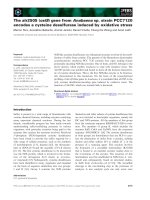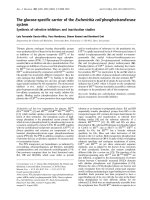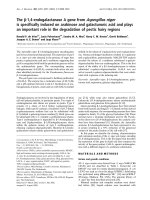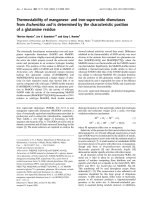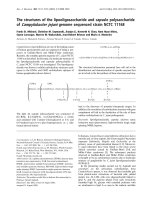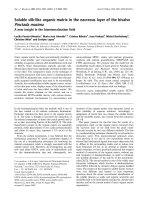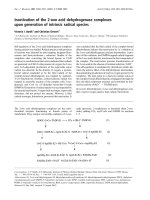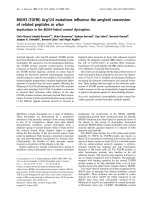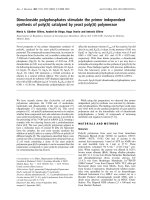Tài liệu Báo cáo Y học: The b-1,4-endogalactanase A gene from Aspergillus niger is specifically induced on arabinose and galacturonic acid and plays an important role in the degradation of pectic hairy regions pdf
Bạn đang xem bản rút gọn của tài liệu. Xem và tải ngay bản đầy đủ của tài liệu tại đây (528.32 KB, 9 trang )
The b-1,4-endogalactanase A gene from
Aspergillus niger
is specifically induced on arabinose and galacturonic acid and plays
an important role in the degradation of pectic hairy regions
Ronald P. de Vries
1†
, Lucie Par
ˇ
enicova
´
1‡
, Sandra W. A. Hinz
2
, Harry C. M. Kester
1
, Gerrit Beldman
2
,
Jacques A. E. Benen
1
and Jaap Visser
1§
1
Molecular Genetics of Industrial Microorganisms and
2
Food Chemistry, Wageningen University, Wageningen, The Netherlands
The Aspergillus niger b-1,4-endogalactanase encoding gene
(galA) was cloned and characterized. The expression of galA
in A. niger was only detected in the presence of sugar beet
pectin,
D
-galacturonic acid and
L
-arabinose, suggesting that
galA is coregulated with both the pectinolytic genes as well as
the arabinanolytic genes. The corresponding enzyme,
endogalactanase A (GALA), contains both active site resi-
dues identified previously for the Pseudomonas fluorescens
b-1,4-endogalactanase.
The galA gene was overexpressed to facilitate purification
of GALA. The enzyme has a molecular mass of 48.5 kDa
and a pH optimum between 4 and 4.5. Incubations of ara-
binogalactans of potato, onion and soy with GALA resulted
initially in the release of
D
-galactotriose and
D
-galactotetra-
ose, whereas prolonged incubation resulted in
D
-galactose
and
D
-galactobiose, predominantly. MALDI-TOF analysis
revealed the release of
L
-arabinose substituted
D
-galacto-
oligosaccharides from soy arabinogalactan. This is the first
report of the ability of a b-1,4-endogalactanase to release
substituted
D
-galacto-oligosaccharides. GALA was not
active towards
D
-galacto-oligosaccharides that were substi-
tuted with
D
-glucose at the reducing end.
Keywords: Aspergillus niger; b-1,4-endogalactanase; galac-
turonic acid; expression; galactan degradation.
Endogalactanases are involved in the degradation of plant
cell wall polysaccharides, in particular pectin. Two types of
arabinogalactan side chains are present in pectin. Type I
consists of a chain of b-1,4 linked
D
-galactopyranose
linkages, while type II contains a backbone of b-1,3-linked
D
-galactopyranose residues that can be substituted with
b-1,6-linked
D
-galactopyranose residues [1]. Both types can
be substituted with a)1-,3-linked
L
-arabinofuranose chains.
Type I arabinogalactan is degraded by b-1,4-endogalacta-
nase and b-galactosidase. b-1,4-Endogalactanases cleave
within the galactan moiety of type I arabinogalactan,
releasing
D
-galacto-oligosaccharides. Bacterial b-1,4-endo-
galactanases release mainly galactotriose and galactotetra-
ose [2–6], while some also release galactobiose [3,5,7].
Eukaryotic b-1,4-endogalactanases release predominantly
galactobiose and galactose from galactan [8–10].
Genes encoding b-1,4-endogalactanase have been cloned
from both bacteria and fungi [11–15]. Based on their derived
amino acid sequence, the corresponding enzymes have been
assigned to family 53 of the glycosyl hydrolases [16]. These
enzymes have a retaining mechanism and for the Pseudo-
monas fluorescens b-1,4-endogalactanase the catalytic resi-
dues have been determined [11]. Recently, the Aspergillus
aculeatus b-1,4-endogalactanase has been expressed in vivo
in potato resulting in a 30% reduction of the galactosyl
content of the pectin fraction of the cell walls [17].
In this paper we describe the cloning, characterization
and expression analysis of the A. niger galA gene, encoding
b-1,4-endogalactanase. This is the first paper that describes
the expression of this gene in detail and that compares the
activity of the gene product, GALA, against arabinogalac-
tans with a different degree of
L
-arabinose substitution.
MATERIALS AND METHODS
Strains and growth conditions
All A. niger strains were derived from A. niger N400 (CBS
120.49) and are described in Table 1. Escherichia coli
DH5aF¢ was used for routine plasmid propagation. E. coli
LE392 was used as a host for phage kEMBL3. Subcloning
was performed using pBluescript SK
+
[18] and pGEM-T
(Promega, Madison, WI, USA). The genomic library of
A. niger has been described previously [19].
Minimal medium and complete medium were descri-
bed before [20]. Liquid cultures were inoculated with
Correspondence to R. P. de Vries, Microbiology, Utrecht University,
Padualaan 8, 3584 CH Utrecht, The Netherlands.
Fax: +31 302513655, Tel.: +31 302533016,
E-mail:
Abbreviations: CREA, carbon catabolite repressor protein; HPAEC,
high performance anion exchange chromatography; GALA, the
A. niger b-1,4-endogalactanase; galA,geneencodingtheA. niger
b-1,4-endogalactanase; Galp, galactopyranose; Glcp, glucopyranose;
LACA, A. niger a-galactosidase; PACC, pH regulatory protein;
TOS, transgalactooligosaccharides.
Present address: Microbiology, Utrecht University, Padualaan 8,
3584 CH Utrecht, The Netherlands.
àPresent address:DipartimentodiBiologia,Universitadeglistudidi
Milano, Via Celoria 26, 20133 Milano, Italy.
§Present address: FGT Consultancy, PO Box 396, 6700 AJ Wagenin-
gen, The Netherlands.
(Received 27 March 2002, revised 1 July 2002,
accepted 21 August 2002)
Eur. J. Biochem. 269, 4985–4993 (2002) Ó FEBS 2002 doi:10.1046/j.1432-1033.2002.03199.x
10
6
sporesÆmL
)1
, and incubated at 30 °Cinanorbital
shaker at 250 r.p.m. For the growth of strains with
auxotrophic mutations, the necessary supplements were
added to the medium.
Transfer experiments were performed by pregrowing the
strains for 16 h in complete medium containing 2% (w/v)
fructose as carbon source, after which the mycelium was
harvested and washed with minimal medium without
carbon source. Aliquots (1.5 g) of wet mycelium were then
transferred to 50 mL minimal medium containing carbon
sources as indicated in the text. After 4 h of incubation in a
rotary shaker at 250 r.p.m and 30 °C mycelium was
harvested, dried between tissue paper, frozen in liquid
nitrogen and stored at )70 °C.
For purification of the b-1,4-endogalactanase, A. niger
transformant NW290:: pIM3982.77 was grown in minimal
medium supplemented with 0.003% (w/v) yeast extract and
3% (w/v) fructose. The pH was adjusted to 3.8. Cultivation
was performed at 30 °C in a 5-litre jacketed stirred tank
reactor (Applikon). Air-saturated culture medium was
inoculated with 10
6
spores per litre. The spores were
allowed to germinate for 6 h at low stirring speed
(400 r.p.m) after which the cultivation was continued for
18 h at 750 r.p.m. Culture pH was maintained at 3.8 by the
addition of a 5-
M
sodium hydroxide solution. The cultures
were sparged with air (2 v.v.m) and 0.5 mL 30% (v/v)
polypropylene glycol in ethanol was added per litre of
medium as antifoam agent.
Materials
D
-Xylose,
D
-glucose,
D
-fructose,
D
-galactose,
D
-mannose,
and lactose were obtained from Merck (Darmstadt,
Germany).
D
-Glucuronic and
D
-galacturonic acid were
from Fluka (Buchs, Switzerland). Mellibiose, raffinose,
stachyose,
L
-arabinose, gum arabic, gum karaya, locust
bean gum, and beechwood xylan were from Sigma (St. Louis,
Mo.). Potato pectic galactan was from Megazyme Interna-
tional (Bray, Ireland). Taq polymerase was from Gibco BRL
(Breda, The Netherlands). All other standard chemicals
were either obtained from Sigma or Merck. Potato arabi-
nogalactan and onion arabinogalactan were obtained as
described previously (Fractions F44) [21]. Soy arabinoga-
lactan was kindly provided by NOVO Nordisk (Dittingen,
Switzerland). Sugar compositions were determined as des-
cribed [21]. Borculo Whey Products (Borculo, The Nether-
lands) kindly provided transgalactooligosaccharides (TOS).
PCR cloning of a specific fragment of
galA
Two oligonucleotides were designed based on the sequence
of the A. aculeatus b-1,4-endogalactanase encoding gene
(5¢-CTCTTCTCTCTTGCTCTTG-3¢ and 5¢-GTTCGTCT
CCACAACCAC-3¢, respectively) and used in PCRs under
the following conditions: 1 min denaturing at 95 °C, 1 min
annealing at 50 °C and 2 min amplification at 72 °C, 30
cycles. Chromosomal DNA of A. niger N402 was used as a
template. This resulted in a fragment of approximately
700 bp which was cloned in pGEM-T easy (Promega).
Sequence analysis was performed as described below.
Cloning and characterization of
galA
Plaque hybridizations were performed as previously des-
cribed [22]. Hybridizations were performed overnight at
65 °CbyusingthegalA PCR fragment as a probe. Filters
were washed to 0.2 · NaCl/Cit (1 · NaCl/Cit is 0.15
M
NaCl plus 0.015
M
Na
3
-citrate, pH 7.6)-0.5% (mass/vol)
SDS. Positive plaques, identified on duplicate replicas after
autoradiography, were recovered from the original plates
and purified by rescreening at low plaque density. Standard
methods were used for other DNA manipulations, such as
Southern analysis, subcloning, DNA digestions, and lambda
phage and plasmid DNA isolations [23]. Chromosomal
DNA was isolated as previously described [24]. Sequence
analysis was performed on both strands of DNA by using
the Cy5 AutoCycle Sequencing kit (Pharmacia Biotech,
Uppsala, Sweden). The reactions were analyzed with an
ALFred DNA Sequencer (Pharmacia Biotech). Nucleotide
sequences were analyzed with computer programs based on
those of Devereux et al. [25]. RT-PCRs were performed
using the Enhanced Avian RT-PCR kit (Sigma) according
to the suppliers instructions using galA-specific oligonucleo-
tides (5¢-GATGATCTACCCTCTGCTTC-3¢ and 5¢-GTC
ACGGACGGACTGGGT-3¢). Northern analysis was per-
formed as described previously [20]. Per sample, 5 lgof
total RNA was loaded on the gel.
The A. niger galA accession number is AJ305303.
Sequence alignments
Nucleic acid and amino acid sequence alignments were
performed by using the Blast programs [26] at the server
of the National Center for Biotechnology Information
(Bethesda, Md., USA).
Purification of b-1,4-endogalactanase
Culture fluid was collected by filtration through cheesecloth
and diluted twofold with distilled water, after which the pH
was adjusted to 6.5 by the addition of sodium hydroxide.
Proteins were collected by batchwise adsorption to Stream-
line Q XL (Amersham Pharmacia Biotech, Sweden). For
this 40 mL of the matrix was added to the culture fluid and
stirred for 2 h. Bound protein was eluted by a pulse of
10 m
M
piperazine/HCl pH 6.0, 1
M
NaCl. After extensive
dialysis against 10 m
M
piperazine/HCl pH 6.0, the protein
was loaded onto a Source 30 Q column (Amersham
Pharmacia Biotech, Sweden, 16 mL) followed by elution
with a 300-mL linear NaCl gradient (0–1
M
). Fractions
(10 mL) were collected and assayed for b-1,4-endogalac-
tanase activity. b-1,4-Endogalactanase containing fractions
were pooled, diluted fivefold with buffer and reapplied to
the same column. Elution was performed with a 300-mL
linear NaCl gradient (0–0.5
M
). The purity of b-1,4-endo-
galactanase was determined by SDS/PAGE.
Table 1. Strains used in this study.
Strain Genotype Reference
N402 cspA1 [42]
NW200 cspA1, bioA1, creA
d
4,
pyrA13/pyrA
+
, areA1/areA
+
[43]
NW290 cspA1, fwnA12, DargB/argB
+
, pyrA6,
prtF28, DpgaA, DpgaB, goxC17
[44]
4986 R. P. de Vries et al.(Eur. J. Biochem. 269) Ó FEBS 2002
Enzyme assays
Transformants producing elevated levels of b-1,4-endoga-
lactanase were selected using AZCL-galactan (Megazyme,
Bray, Ireland) according to the supplier’s instructions.
During the purification endogalactanase activity was moni-
tored using azo-galactan (Megazyme) as the substrate. Two
hundred microlitres of a solution of 1% (w/v) azo-galactan
in water was mixed with 50 lL of a 50-m
M
sodium acetate
buffer (pH 4.2) followed by the addition of 50 lL enzyme
solution. Incubations were performed for 20 min at 40 °C.
Reactions were stopped by the addition of 650 lL ethanol.
The precipitated substrate was removed by centrifugation
and the supernatant was used to measure absorbance at
590 nm. The pH optimum of GALA was determined using
azo-galactan as described above with a pH range of 3.5–7.5.
The specific activity of GALA was determined using
GALACTAZYME tablets (Megazyme) with conditions as
indicated by the supplier and using 0, 10, 25, 50, 100, 200
and 500 lL of the GALA preparation. Incubations were
performed in duplicate.
The hydrolysis activity of GALA with different arabino-
galactans was measured in duplicate by HPAEC and
MALDI-TOF MS after incubation of 1 mgÆmL
)1
of
potato, onion and soy arabinogalactan with 1.33 lgÆmL
)1
GALA at 30 °C, pH 4.5 (McIlvain buffer) for 15 min,
30 min, 2 h and 20 h, respectively. The incubation was
stopped by heating the samples for 5 min at 100 °C.
Transgalactooligosaccharides (TOS) were incubated in
duplicate with GALA to analyse the activity of the enzyme
towards these oligosaccharides. The oligosaccharides used
all contained a glucose residue at the reducing end and were:
b-D-Galp-1,4-D-Glcp (b-D-Galp-1,4-)
2
D-Glcp (b-D-Galp-
1,4-)
3
D-Glcp (b-D-Galp-1,4-)
4
D-Glcp (b-D-Galp-1,4-)
5
D-
Glcp. Incubations were performed in duplicate. For this,
0.5 mgÆmL
)1
of TOS was incubated with 1.33 lgÆmL
)1
GALA at 30 °C, pH 4.5 (McIlvain buffer) for 15 min,
30 min, 2 h and 20 h, respectively. The incubation was
stopped by heating the samples for 5 min at 100 °C.
a-L-1,3-Arabinofuranosidase activity in the GALA pre-
paration was measured as described before [27], using 10
and 100 lL of the enzyme preparation (in duplicate) and
incubation times of 1 and 4 h.
Analytical methods
SDS/PAGE. Electrophoresis of proteins was performed
under denaturing conditions on 10% (w/v) gels using the
method of Laemmli [28] in a Mini-V system (Life
Technologies B.V., Breda, The Netherlands).
HPAEC. High performance anion exchange chromato-
graphy (HPAEC) was performed using a SpectraSystem
P4000 (Thermo Separation Products) equipped with a Dio-
nex CarboPac PA-1 (4 · 250 mm) column and a Dionex
ED40 Electrochemical Detector in de Pulsed Amperometric
Detection mode. The samples were analyzed using a linear
gradient of 0–400 m
M
sodium acetate in 100 m
M
sodium
hydroxide for 40 min
D
-galactose,
D
-galactobiose and
D
-galactotetraose were used as standards to identify the
D
-galactose and
D
-galacto-oligosaccharides. The calculated
areas for
D
-galactose and
D
-galacto-oligosaccharides were
expressed as percentages of the area of 1 m
MD
-galactose.
MALDI-TOF MS. MALDI-TOF MS was performed
with a Voyager-DE RP Biospectrometry Workstation
(PerSeptive Biosystems, Framingham, VS) in the positive
mode. The laser intensity was 2300, the pulsed delay time
was 200 nsec, the accelerating voltage was 12 000 V, the
grid voltage was 7200 V and the guide wire voltage was
9.6 V. The instrument was used in the reflector mode. The
mass spectrometer was calibrated with maltodextrins.
RESULTS
Cloning and characterization of
galA
Based on the sequence of the Aspergillus aculeatus b-1,4-
endogalactanase encoding gene, two oligonucleotides were
designed and used in PCRs, resulting in a specific
fragment of A. niger galA, as described in Material and
methods. Screening of a genomic library of A. niger using
this fragment as a probe resulted in the isolation of two
galA-containing phage k clones. From one of these clones
a4.5-kbEcoRI fragment was cloned into pBluescript
SK
+
, resulting in plasmid pIM3980. Double stranded
sequence was determined for a region of this construct
containing galA and some of the flanking regions,
resulting in the genomic sequence of A. niger galA.The
presence of one putative intron was confirmed by RT-
PCR using total RNA of A. niger mycelium (transferred
to minimal medium containing 15 m
MD
-galacturonic
acid) as a template. The galA gene has a length of
1122 bp, is interrupted by one intron of 72 bp, and
encodes a protein of 350 amino acids. Computer analysis
predicted a eukaryotic signal sequence of 16 amino acids.
The putative mature enzyme has a calculated pI of 3.67, a
calculated molecular mass of 37 053.9 Da and contains
one potential N-glycosylation site. BLAST analysis of the
deduced amino acid sequence of GALA revealed very
high similarity to the endogalactanases of A. tubingensis
(95.7% amino acid sequence identity) and A. aculeatus
(78.9% amino acid sequence identity) and lower similarity
to bacterial endogalactanases (between 21% and 28%
amino acid sequence identity). This is illustrated by a
CLUSTALW analysis [29] of the deduced amino acid
sequences of GALA and b-1,4-endogalactanases of
Aspergillus tubingensis [15], A. aculeatus [12], Bacillus
circulans (Acc. No. P48843), Yersinia pestis [14], Bacillus
subtilis (Acc. No. O07013), Clostridium acetobutylicum
[13], and Pseudomonas fluorescens [11] (Fig. 1). Both
catalytic residues identified in P. fluorescens (E161, E270)
[11] are present in the eukaryotic b-1,4-endogalactanases.
Sequence analysis of the promoter of galA revealed the
presence of several sequences possibly involved in the
regulation of galA expression. Putative CREA binding sites
[30] were detected at position )204, )218, 299, )482, and
)580 from the start codon. In addition, one putative PACC
site ()549) [31] and two CCAAT sites ()280, )300) were
detected.
Expression analysis of
galA
The expression pattern of galA on a selection of mono-
saccharides, oligosaccharides and polysaccharides was com-
pared to the previously reported expression pattern of lacA
(encoding b-galactosidase) (Fig. 2) [32]. For this, mycelium
Ó FEBS 2002 A. niger b-1,4-endogalactanase (Eur. J. Biochem. 269) 4987
was pregrown as described in Material and methods, and
transferred for 4 h to minimal medium containing carbon
sources as indicated in Fig. 2. Expression of galA was only
detected in the presence of sugar beet pectin, whereas
expression of lacA was detected in the presence of
L
-arabi-
nose,
D
-xylose, sugar beet pectin and xylan (Fig. 2).
To determine which of the monosaccharides present in
sugar beet pectin is the actual inducer of galA expression a
Fig. 1. Alignment of the derived amino acid sequences of fungal and bacterial b-(1,4)-endogalactanase encoding genes. In the consensus sequence the
amino acids indicated are those present in at least four sequences. Amino acids present in all sequences are in bold. The eukaryotic signal sequence
of A. niger GALA is depicted in lower case letters. The putative N-glycosylation site of A. niger GALA is in bold, italics, underlined and indicated
above the sequence ("). The two catalytic residues identified in the P. fluorescens endogalactanase [11] are indicated above the alignment (^)andare
in white against a grey background.
4988 R. P. de Vries et al.(Eur. J. Biochem. 269) Ó FEBS 2002
second experiment with identical experimental setup was
performed in which the expression of galA was studied in
two strains, a wild type (N402) and a mutant with a
derepressed phenotype for CREA repression (NW200).
Five of the carbon sources used in this experiment (
D
-xylose,
L
-arabinose,
D
-galactose,
L
-rhamnose,
D
-galacturonic acid,
Fig. 3) have been identified as components of sugar beet
pectin [1], whereas the others served as controls. Expression
of galA in the wild type strain was only detected in
the presence of
D
-galacturonic acid (Fig. 3). However, in the
CREA mutant expression of galA was detected in the
presence of
D
-galacturonic acid and
L
-arabinose.
The expression of galA is very low on the inducing
compounds. Using approximately 50 ng of the PCR
product for labelling, the radiation level of the probe after
purification was 42.6 kBq. It was necessary to expose the
autoradiogram for two weeks in order to visualize the
hybridizing bands.
Purification and characterization of GALA
To obtain an A. niger transformant that produces increased
levels of b-1,4-endogalactanase, a construct was made in
which galA was fused to the promoter of the A. niger pkiA
gene, encoding pyruvate kinase [24]. This gene has a high
constitutive expression level and has been used previously
for the production of high levels of proteins in A. niger [33].
The fusion construct (pIM3982) was made by introducing
an NsiI site at the translation start point of galA and by then
cloning a fragment, starting at this NsiI site and containing
the galA gene and approximately 700 bp 3¢-flanking region,
in pIM4700 (containing the pkiA promoter). A. niger
NW290 was transformed with pIM3982 and transformants
were analyzed for b-1,4-endogalactanase production using
azo-galactan. Transformant NW290::pIM3982.77 was
selected as the highest b-1,4-endogalactanase producing
transformant and was used for the purification of GALA.
Growth of this transformant and subsequent purification of
the enzyme were performed as described in Materials and
methods. Purity of the preparation was checked by SDS/
PAGE (Fig. 4). The purification resulted in 10 mL of the
GALA preparation with a concentration of 31.6 lgÆmL
)1
.
Using galactazyme tablets a specific activity of 12.3 UÆmg
)1
was determined for GALA.
The purified protein had a molecular mass of 48.5 kDa as
determined by SDS/PAGE (Fig. 4). The pH optimum was
between4and4.5.
No activity of GALA could be detected against any of
the transgalactooligosaccharides listed in Materials and
methods.
Hydrolysis of arabinogalactans
The sugar composition of the arabinogalactans from
potato, onion and soy was determined as described [21].
Onion arabinogalactan consists of 99%
D
-galactose and
0.3%
L
-arabinose and is predominantly linear. Potato
arabinogalactan consists of 86%
D
-galactose and 6.6%
L
-arabinose, while soy arabinogalactan consists of 57%
D
-galactose and 38%
L
-arabinose. Methylation analysis
demonstrated that a substantial amount of the
L
-arabinose
residues (14%) in soy arabinogalactan is present as terminal
residues [21], suggesting that of these arabinogalactans, soy
arabinogalactan is the most highly branched substrate.
Fig. 2. Comparison of the expression of the
A. niger b-(1,4)-endogalactanase (galA)and
b-galactosidase (lacA) encoding gene. A frag-
ment of the 18S rRNA gene [45] was used as
an RNA loading control.
Fig. 3. Expression of galA in the presence of
different monomeric carbon sources in the wild
type and CREA derepressed A. niger strains.
A fragment of the 18S rRNA gene [45] was
used as an RNA loading control.
Ó FEBS 2002 A. niger b-1,4-endogalactanase (Eur. J. Biochem. 269) 4989
The three arabinogalactans were incubated with GALA
for 15 min, 30 min, 2 h and 20 h to determine the substrate
specificity of the enzyme. The degradation of the polymer
and subsequent oligosaccharide formation was analyzed by
HPAEC and MALDI-TOF MS. HPAEC analysis demon-
strated that already after 15 min the formation of tetramers,
trimers, dimers and monomers of
D
-galactose was visible for
all three substrates (Fig. 5). Using potato and onion
arabinogalactan as substrate, a small increase in all four
products is observed during the incubation. The product
formation using soy arabinogalactan as a substrate is clearly
different (Fig. 5). After initial release of trimers and
tetramers, these products disappear during prolonged
incubation. A relatively higher amount of monomers
and dimers is released from soy arabinogalactan, which
increased upon prolonged incubation.
MALDI-TOF MS analysis allowed for a more detailed
analysis of the products formed during the incubations,
although the method used cannot detect monomers and
dimers. GALA initially released
D
-galactotriose,
D
-galacto-
tetraose and
D
-galactopentaose from potato and onion
arabinogalactan, while after prolonged incubations pre-
dominantly
D
-galactotriose and
D
-galactotetraose could be
detected (Fig. 6). Using soy arabinogalactan as a substrate,
not only
D
-galactotriose,
D
-galactotetraose and
D
-galacto-
pentaose were detected but also
L
-arabinose substituted
forms of these three oligosaccharides (Fig. 6). After pro-
longed incubations (2 h), only
D
-galactotriose could be
detected. However, HPAEC demonstrated that after even
longer incubations (20 h)
D
-galactotriose also disappears.
To determine whether a small amount of a-
L
-1,3-arabino-
furanosidase was responsible for the disappearance of
Fig. 4. SDS/PAGE-of the purified b-(1,4)-endogalactanase prepar-
ation. 1, 2: purified GALA preparation; 3: molecular mass marker
proteins.
Fig. 5. HPAEC analysis of the hydrolysis of arabinogalactans by GALA. Three different arabinogalactans were used: potato (r), onion (j)andsoy
(m). The release of monomers (A), dimers (B), trimers (C) and tetramers (D) was studied during the incubations. The areas calculated for
D
-galactose and
D
-galacto-oligosaccharides were expressed as percentages of the area of 1 m
MD
-galactose. The values used for the figure are the
average of duplicate incubations.
4990 R. P. de Vries et al.(Eur. J. Biochem. 269) Ó FEBS 2002
the
L
-arabinose-substituted oligosaccharides the GALA
preparation was assayed for this activity. However, no
a-
L
-1,3-arabinofuranosidase activity could be detected in
the preparation (data not shown).
This paper demonstrates the important role of GALA in
the degradation of both linear and
L
-arabinose-substituted
galactan side chains of pectin. This is in agreement with a
previous study in which the synergy of enzymes degrading
the pectin side chains was studied [34]. GALA had a positive
effect on the activity of the other enzymes involved in the
degradation of these side chains.
DISCUSSION
A. niger galA is highly similar to the b 1,4-endogalactanase
encoding genes from A. tubingensis and A. aculeatus.The
similarity of the galA genesishigherbetweenthetwo
biseriate species, A. niger and A. tubingensis,thanbetween
the monoseriate A. aculeatus galA gene and either of the
other two Aspergillus genes. A similar observation has
previously been reported for pectin lyase encoding genes of
these species [35]. Significant similarity was also detected to
a number of bacterial b-1,4-endogalactanases. The highest
similarity was detected in the region around the first
catalytic residue identified for the P. fluorescens b-1,4-
endogalactanase [11]. The similarity around the second
catalytic residue is lower.
The determined molecular mass for A. niger GALA
(48.5 kDa) is higher than the molecular mass based on the
amino acid sequence (37 kDa). This suggests that the puta-
tive N-glycosylation site identified in the sequence is indeed
functional. The determined molecular mass and pH opti-
mum (pH 4–4.5) of GALA are similar to those reported pre-
viously for Aspergillus b-1,4-endogalactanases [10,12,36–40].
Expression of galA was observed in the presence of sugar
beet pectin,
D
-galacturonic acid and
L
-arabinose. As A. niger
is not able to import pectin, it is likely that the latter two
compounds, or metabolites derived from them, are the true
inducers of galA expression. This indicates that galA is
coexpressed with both the pectinolytic genes encoding main
chain cleaving enzymes as well as with the arabinanolytic
genes [1]. The absence of expression of galA in the presence
of pectic galactan indicates that galactose is not an inducer
of galA expression. This is in agreement with a role for
L
-arabinose and
D
-galacturonic acid as inducers as men-
tioned above. Expression of lacA is also detected in the
presence of these compounds, but in the presence of
D
-xylose
and xylan as well. This can be explained by the structure of
the polysaccharides. Xylan contains single b-1,4-linked
D
-galactose residues but no b-1,4-linked galactan chains.
Therefore it only requires an exo-acting galactose releasing
enzyme (LACA). Previously it was shown that lacA is under
the control of the xylanolytic activator protein [32,41]. The
increase in expression levels of galA in the CREA mutant,
indicates that at least one of the detected putative CREA
binding sites in the promoter of galA is functional.
Hydrolysis of arabinogalactans with a different degree of
L
-arabinose substitution by GALA results in different
products. Arabinogalactans with a low degree of
L
-arabi-
nose substitution (potato, onion) as substrates result in the
liberation of monomers, dimers, trimers and tetramers of
D
-galactose. Using arabinogalactans with a high degree of
L
-arabinose substitution (soy), higher oligomers appear
initially, but these disappear if the incubation is continued.
Another difference is that only with the latter substrate
arabinose-substituted galacto-oligosaccharides are detected.
These disappear in time, suggesting the presence of an
arabinose-releasing activity in the GALA preparation.
However, no a-1-,3-
L
-arabinofuranosidase activity could
be detected using PNP-a-
L
-arabinofuranoside as a sub-
strate. This most likely means that the removal of the
L
-arabinose residues from the galactomannan oligosaccha-
rides is caused by traces of an enzyme in the b-1,4-
endogalactanase preparation that is not active against the
PNP-substrate. Galacto-oligosaccharides that were sub-
stituted with
D
-glucose at the reducing end were not
Fig. 6. Maldi-TOF MS analysis of the hydrolysis of arabinogalactans by GALA. Three different arabinogalactans were used: potato (A), onion (B),
and soy (C). Spectra were taken after 15 min (1) and 2 h (2) of incubation with GALA.
Ó FEBS 2002 A. niger b-1,4-endogalactanase (Eur. J. Biochem. 269) 4991
hydrolyzed by GALA. So, heterosugar oligosaccharides
with the structures Gal–Gal–Glc and Gal–Gal–Gal–Glc can
not be hydrolyzed, while their corresponding homosugar
oligosaccharides Gal3 and Gal4 are degradable (Fig. 5,
panels C and D). This indicates that the substrate binding
site in GALA that binds the reducing-end sugar is very
important in enzyme substrate interaction. Previous studies
using an Aspergillus b-1,4-endogalactanases reported release
of
D
-galactose and
D
-galactobiose from arabinogalactan,
after initial release of
D
-galactotriose and
D
-galactotetraose
[10,12,36,39]. However, none of these papers reported the
release of
L
-arabinose substituted galacto-oligosaccharides.
ACKNOWLEDGEMENTS
The authors thank Simon Flitter for the identification and isolation
of the galA containing phage clones and Matthew Illsley for the
analysis of a-
L
-1,5-arabinofuranosidase activity in the endogalactanase
preparation.
REFERENCES
1. de Vries, R.P. & Visser, J. (2001) Aspergillus enzymes involved in
degradation of plant cell wall polysaccharides. Microb.Mol.Biol.
Rev. 65, 497–522.
2. Labavitch, J.M., Freeman, L.E. & Albersheim, P. (1976) Puri-
fication and characterization of a b-1,4-galactanase which
degrades a structural component of the primary cell walls of
dicots. J. Biol. Chem. 251, 5904–5910.
3. Emi, S., Fukumoto, J. & Yamamoto, T. (1971) Studies of hemi-
cellulolytic enzymes of Bacillus subtilis.PartI.Purification,crys-
tallization and some properties of arabinogalactanase. Agric. Biol.
Chem. 35, 1891–1898.
4. Emi, S. & Yamamoto, T. (1972) Purification and properties of
several galactanases of Bacillus subtilis var. amylosacchariticus.
Agric. Biol. Chem. 36, 1945–1954.
5. Tsumura, K., Hashimoto, Y., Akiba, T. & Hirokoshi, K. (1991)
Purification and properties of galactanases from alkalophilic
Bacillus sp. S-2 and S-39. Agric. Biol. Chem. 55, 1265–1271.
6. Yamamoto, T. & Emi, S. (1988) Arabinogalactanase of Bacillus
subtilis var. amylosacchariticus. Methods Enzymol. 160, 719–728.
7. Nakano, H., Takenishi, S., Kitahata, S., Kinugasa, H. &
Watanabe, Y. (1990) Purification and characterization of an
exo-1,4-b-galactanase from a strain of Bacillus subtilis. Eur. J.
Biochem. 193, 61–67.
8. Konno, H., Yamasaki, Y. & Katoh, K. (1986) Characteristics of
b-galactosidase purified from cell suspension cultures of carrot.
Physiol. Plant. 68, 46–52.
9. Nakano, H., Takenishi, S., Kinugasa, H. & Watanabe, Y. (1985)
Purification and properties of two galactanases from Penicillium
citrinum. Agric. Biol. Chem. 49, 3445–3454.
10. Lahaye, M., Vigouroux, J. & Thibault, J F. (1991) Endo-b-1,4-
D-galactanase from Aspergillus niger var.aculeatus:Purification
and some properties. Carbohydr. Polymers 15, 431–444.
11. Braithwaite, K.L., Barna, T., Spurway, T.D., Charnock, S.J.,
Black, G.W., Hughes, N., Lakey, J.H., Virden, R., Hazlewood,
G.P., Henrissat, B. & Gilbert, H.J. (1997) Evidence that galacta-
nase A from Pseudomonas fluorescens subspecies cellulosa is a
retaining family 53 glycosyl hydrolase in which E161 and E270 are
the catalytic residues. Biochem. 36, 15489–15500.
12. Christgau, S., Sandal, T., Kofod, L.V. & Dalboge, H. (1995)
Expression cloning, purification and characterization of a
b-1,4-galactanase from Aspergillus aculeatus. Curr. Genet. 27,135–
141.
13. Nolling, J., Breton, G., Omelchenko, M.V., Markarova, K.S.,
Zeng, Q., Gibson, R., Lee, H.M., Dubois, J., Qiu, D., Hitti, J.,
Wolf, Y.I., Tatusov, R.L., Sabathe, F., Doucette-Stamm, L.,
Soucaille, P., Daly, M.J., Bennett, G.N., Koonin, E.V. & Smith,
D.R. (2001) Genome sequence and comparative analysis of the
solvent-producing bacterium Clostridium acetobutylicum. J. Bac-
teriol. 183, 4823–4838.
14. Parkhill, J., Wren, B.W., Thomson, N.R., Titball, R.W., Holden,
M.T.G.,Prentice,M.B.,Sebaihia,M.,James,K.D.,Churcher,C.,
Mungall, K.L., Baker, S., Basham, D., Bentley, S.D., Brooks, K.,
Cerdeno-Tarraga, A.M., Chillingworth, T., Cronin, A., Davies,
R.M., Davis, P., Dougan, G., Feltwell, T., Hamlin, N., Holroyd,
S.,Jagels,K.,Leather,S.,Karlyshev,A.V.,Moule,S.,Oyston,
P.C.F., Quail, M., Rutherford, K., Simmonds, M., Skelton, J.,
Stevens, K., Whitehead, S. & Barrell, B.G. (2001) Genome
sequence of Yersinia pestis, the causative agent of plague. Nature
413, 523–527.
15. Vlugt-Bergmans, C.J.B. & van Ooijen, A.J.J. (1999) Expression
cloning in Kluyveromyces lactis. Biotechniques 13, 87–92.
16. Henrissat, B. & Bairoch, A. (1993) New families in the classifica-
tion of glycosidases based on amino acid sequence similarities.
Biochem. J. 293, 781–788.
17. Sorenson, S.O., Pauly, M., Bush, M., Skjot, M., McCann, M.C.,
Borkhardt, B. & Ulskov, P. (2000) Pectin engineering: Modifica-
tion of potato pectin by in vivo expression of an endo-1,4-beta-
D
-galactanase. Proc. Natl Acad. Sci. USA 97, 7639–7644.
18. Short, J.M., Fernandez, J.M., Sorge, J.A. & Huse, W.D. (1988)
Lambda ZAP: a bacteriophage expression vector with in vivo
excision properties. Nucleic Acids Res. 16, 7583–7600.
19. Harmsen, J.A.M., Kusters-van Someren, M.A. & Visser, J. (1990)
Cloning and expression of a second Aspergillus niger pectin lyase
gene (pelA): indications of a pectin lyase gene family in A. niger.
Curr. Genet. 18, 161–166.
20. de Vries, R.P. & Visser, J. (1999) Regulation of the feruloyl
esterase (faeA)genefromAspergillus niger. Appl. Environ.
Microbiol. 65, 5500–5503.
21. van de Vis, J.W. (1994) Characterization and mode of action of
enzymes degrading galactan structures of Arabinogalactans.PhD
Thesis, Wageningen University, Wageningen.
22. Benton, W.D. & Davies, R.W. (1977) Screening kgt recombinant
clones by hybridization to single plaques in situ. Science 196,
180–182.
23. Sambrook, J., Fritsch, E.F. & Maniatis, T. (1989) Molecular
Cloning – A Laboratory Manual., 2nd edn. Cold Spring Harbour
Laboratory, Cold Spring Harbour, NY
24. de Graaff, L.H., van den Broek, H.W.J. & Visser, J. (1988)
Isolation and transformation of the pyruvate kinase gene of
Aspergillus nidulans. Curr. Genet. 13, 315–321.
25. Devereux,J.,Haeberli,P.&Smithies,O.(1984)Acomprehensive
set of sequence analysis programs for the vax. Nucleic Acids Res.
12, 387–395.
26. Altschul, S.F., Gish, W., Miller, W., Myers, E.W. & Lipman, D.J.
(1990) Basic local alignment search tool. J. Mol. Biol. 215,
403–410.
27. van der Veen, P., Flipphi, M.J.A., Voragen, A.G.J. & Visser, J.
(1991) Induction, purification and characterisation of arabinases
produced by Aspergillus niger. Arch. Microbiol. 157, 23–28.
28. Laemmli, U.K. (1970) Cleavage of structural proteins during the
assembly of the head of bacteriophage T4. Nature 227, 680–685.
29. Thompson, J.D., Higgins, D.G. & Gibson, T.J. (1994) CLUSTAL
W: improving the sensitivity of progressive multiple sequence
alignment through sequence weighting, positions-specific gap
penalties and weight matrix choice. Nucl. Acids Res. 22, 4673–
4680.
30. Kulmburg, P., Mathieu, M., Dowzer, C., Kelly, J. & Felenbok, B.
(1993) Specific binding sites in the alcR and alcA promoters of the
ethanol regulon for the CreA repressor mediating carbon cata-
bolite repression in Aspergillus nidulans. Mol. Microbiol. 7,847–
857.
4992 R. P. de Vries et al.(Eur. J. Biochem. 269) Ó FEBS 2002
31. Orejas, M., Espeso, E.A., Tilburn, J., Sarkar, S., Arst, H.N.J. &
Penalva, M.A. (1995) Activation of the Aspergillus PacC tran-
scription factor in response to alkaline ambient pH requires pro-
teolysis of the carboxy-terminal moiety. Genes & Development. 9,
1622–1632.
32. de Vries, R.P., van den Broeck, H.C., Dekkers, E., Manzanares,
P., de Graaff, L.H. & Visser, J. (1999) Differential expression
of three a-galactosidase genes and a single b-galactosidase
gene from Apergillus niger. Appl. Environ. Microbiol. 65, 2453–
2460.
33. Kusters-van Someren, M., Flipphi, M., de Graaff, L.H., van den
Broeck, H., Kester, H., Hinnen, A. & Visser, J. (1992) Char-
acterisation of the Aspergillus niger pelB gene: structure and regu-
lation of expression. Mol. General Genet. 234, 113–120.
34. de Vries, R.P., Kester, H.C.M., Poulsen, C.H., Benen, J.A.E. &
Visser, J. (2000) Synergy between accessory enzymes from
Aspergillus in the degradation of plant cell wall polysaccharides.
Carbohydr. Res. 327, 401–410.
35. Par
ˇ
enicova
´
, L., Benen, J.A.E., Samson, R.A. & Visser, J. (1997)
Evaluation of RFLP analysis of the classification of selected black
Aspergilli. Mycol. Res. 101, 810–814.
36. Kimura, I., Yoshioka, N. & Tajima, S. (1998) Purification and
characterization of an endo-1,4-b-D-galactanase from Aspergillus
sojae. J. Ferment. Bioeng. 85, 48–52.
37. Muzakhar, K., Hayashi, H., Kawaguchi, T., Sumitani, J. & Arai,
M. (1999) Purification and properties of a-
L
-arabinofuranosidase
and endo-b-D-1,4-galactanase from Aspergillus niger v. Tieghem
KF-267 which liquified the Okara. In Genetics, Biochemistry and
Ecology of Cellulose Degradation. (Ohmiya, K., Sakka, K., Karita,
S., Hayashi, H., Kobayashi, Y. & Kimura, T., eds), pp. 134–143.
Uni Publishers Co Ltd, Tokyo.
38. Schopplein, E. & Dietrich, H. (1991) Charakterisierung poly-
saccharidspaltender begleitaktivitaten in einem technischen pek-
tinasepreparat. Deutsche Lebensmittel-Rundschau. 87, 212–219.
39. van de Vis, J.W., Searle-van Leeuwen, M.J.F., Siliha, H.A.,
Kormelink, F.J.M. & Voragen, A.G.J. (1991) Purification and
characterization of endo-1,4-b-D-galactanases from Aspergillus
niger and Aspergillus aculeatus: Use in combination with arabin-
ases from Aspergillus niger in enzymic conversion of potato ara-
binogalactan. Carbohydr. Polymers 16, 167–187.
40. Yamaguchi, F., Inoue, S. & Hatanaka, C. (1995) Purification
and properties of endo-b-1,4-galactanase from Aspergillus niger.
Biosci. Biotechn Biochem. 59, 1742–1744.
41. van Peij, N.N.M.E., Visser, J. & de Graaff, L.H. (1998) Isolation
and analysis of xlnR, encoding a transcriptional activator
coordinating xylanolytic expression in Aspergillus niger. Mol.
Microbiol. 27, 131–142.
42. Bos, C.J., Debets, A.J.M., Swart, K., Huybers, A., Kobus, G. &
Slakhorst, S.M. (1988) Genetic analysis and the construction of
master strains for assignment of genes to six linkage groups in
Aspergillus niger. Curr. Genet. 14, 437–443.
43. de Vries, R.P., Visser, J. & de Graaff, L.H. (1999) CreA modulates
the XlnR induced expression on xylose of Aspergillus niger genes
involved in xylan degradation. Res. Microbiol. 150, 281–285.
44. Warren, M.E., Kester, H., Benen, J., Colangelo, J., Visser, J.,
Bergmann, C. & Orlando, R. (2002) Studies on the glycosylation
of wild type and mutant forms of Aspergillus niger pectin methy-
lesterase. Carbohydr. Res. 337, 803–812.
45. Melchers,W.J.G.,Verweij,P.E.,vandenHurk,P.,vanBelkum,
A., de Pauw, B.E., Hoogkamp-Korstanje, A.A. & Meis, J.F.G.M.
(1994) General primer-mediated PCR for detection of Aspergillus
species. J. Clin. Microbiol. 32, 1710–1717.
Ó FEBS 2002 A. niger b-1,4-endogalactanase (Eur. J. Biochem. 269) 4993
